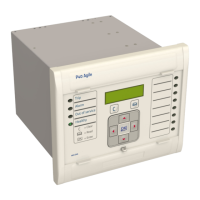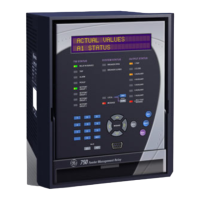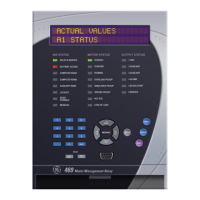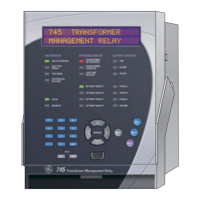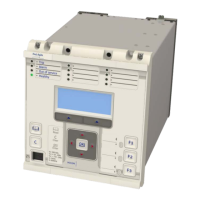GEK - 105560
33
7.6 CONTINUOUS AND MANUAL MODE TESTS
With the default settings, the delay in continuous mode is 0.1 s and in manual mode it is 10 s. This
helps to know when the relay acts in one mode or the other.
Manual mode
Apply continuous voltage to inputs MANUAL, ENABLE and 52b.
Apply 60 V in parallel to line and buses.
When approximately 10 seconds are up (plus some delay with the measurement units and output
relays, which in any case, is less than 100 ms) the relay should function.
Remove the voltage to the ENABLE or 52b input. The relay should drop.
Continuous mode
Apply continuous voltage to input 52b .
Apply 60 V in parallel to line and buses.
When approximately 100 milliseconds are up (plus some delay with the measurement units and output
relays, less than 80 ms in any case) the relay should operate.
Remove the voltage to input 52b (simulates closure of the circuit breaker). The relay should drop.
7.7 CALIBRATION
The MLJ relay is based on a microprocessor and performs numerical processing of alternating
voltages, with high resolution and accuracy. It uses an algorithm that is highly unaffected by distortion
to measure the RMS value. Due to minimal usage of components and the reliability of the
measurement, it not considered necessary to recalibrate the relay.
Nevertheless, and simply for information purposes, see section 6.3, CALIBRATION SEQUENCE.
7.8 GROUNDING
The MLJ has a terminal (B12) for grounding. Connected to this terminal there is also a strip that
connects the terminal to the relay case. This strip improves the discharge path of interference and
must
always be connected
; it must not be disconnected even when an insulation test is being
performed.
Grounding is done with a cable that leads directly to ground of the panel or the cabinet; it should never
go through disconnecting terminals (that might become disconnected), nor should grounding between
equipment be linked. Each one or each case must have its own cable which is directly connected.
In relays with communications or if a cable with a shield is used, the shield should be connected to the
terminal intended for this purpose (B11), without interrupting continuity, and not connecting to the
ground. However, for personal safety, and in order to divert interference to ground, it must always be
connected to the ground in at least one point. Generally the most convenient place is on the side of the
communications controller. By doing this, grounding the cable is achieved as well as avoiding
circulation of currents through the cable which could affect the correct operation of communications.
There are several reasons for grounding a relay such as the MLJ:
•
Personal safety.
A defect in insulation could allow the relay case to come in contact with
conductors that may deliver dangerous ground voltages. The differences in voltage to ground are
